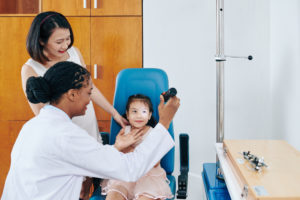Infantile glaucoma is a rare and serious eye disease that appears from birth or during the first few years of life. It is characterised by an abnormal increase in intraocular pressure, which can damage the optic nerve and lead to loss of vision. Infantile glaucoma differs from adult glaucoma in its causes, symptoms and treatment.
Causes
Congenital abnormalities of the eye’s drainage system cause infantile glaucoma in most cases. These abnormalities prevent the intraocular fluid, called aqueous humour, from draining properly: this causes a build-up of pressure inside the eye. The anomalies may be hereditary or occur spontaneously during embryonic development.

Among the most common causes are :
– Primary congenital glaucoma. This is present from birth and results from a malformation of the trabeculum, the structure responsible for draining the aqueous humour.
– Secondary glaucoma. This is associated with other ocular or systemic diseases, such as Sturge-Weber syndrome, congenital rubella or anomalies in the development of the anterior segment of the eye.
– Genetic factors. These play an important role in some cases of childhood glaucoma. Specific genetic mutations may be involved in the development of the disease.
Symptoms
The symptoms of childhood glaucoma can vary depending on the age of the child and the severity of the disease. Parents and healthcare professionals should look out for the following signs:
– Abnormally large and bulging eyes, due to increased intraocular pressure.
– Sensitivity to light (photophobia), which may be accompanied by excessive tearing.
– Eye pain and irritation, leading to frequent crying and restlessness in infants.
– Visual difficulties, such as abnormal eye movements, staring or an inability to follow objects.
– Corneal opacification, which can make the cornea cloudy and affect vision.
Diagnosis of infantile glaucoma
Diagnosis of childhood glaucoma requires a full ophthalmological assessment by a paediatric eye specialist.

The main examinations and tests include
– Measurement of intraocular pressure (tonometry). This enables to detect an abnormal increase in pressure inside the eye.
– Examination of the structure of the eye, in particular the trabeculum and optic nerve. This is carried out using imaging techniques such as ultrasonography or optical coherence tomography (OCT).
– Observation of the eye using a slit microscope (biomicroscopy), to detect abnormalities of the cornea, iris and lens.
The role of parents and healthcare professionals
Parents play a crucial role in the early detection and management of childhood glaucoma. They must be vigilant and consult a paediatric ophthalmologist as soon as symptoms appear. Healthcare professionals, including paediatricians and ophthalmologists, work together to provide appropriate care and coordinate treatment.

Which treatment for infantile glaucoma?
Treatment for childhood glaucoma aims to reduce intraocular pressure, preserve vision and prevent irreversible damage to the optic nerve. Treatment options include:
– Medication, such as eye drops and tablets. These help to reduce the production of aqueous humour or improve its drainage. Medications may include beta-blockers, carbonic anhydrase inhibitors and prostaglandin analogues.
– Surgery, which is often necessary to correct drainage abnormalities and reduce intraocular pressure. Possible surgical procedures include trabeculectomy, goniotomy, trabeculotomy and implantation of drainage devices.
– Laser therapy. This improves drainage of the aqueous humour by creating small openings in the trabeculum.
Rheon Medical: A revolution in the treatment of glaucoma
Rheon Medical is a pioneering company in the development of innovative solutions for the treatment of glaucoma. Founded by experts in medical engineering and advised by expert ophthalmologists, Rheon Medical is focusing its efforts on research and innovation to treat adult glaucoma. In the future, it plans to offer devices that can also be adapted to the needs of young patients.
Why can’t existing implants be adapted for children?
The implants currently available were designed primarily for adult patients, whose anatomical and pathophysiological characteristics differ significantly from those of children. In children, glaucoma is often linked to a congenital or developmental malformation, whereas in adults it is generally an acquired pathology, influenced by factors such as age, environment or co-morbidities.
Consequently, the size of ocular structures, the continuous growth of the eye and the more aggressive post-operative tissue response in children make the adaptation of adult devices inappropriate.
Recognising these specific challenges – more fragile anatomy, increased risk of fibrosis, and difficulty in predicting long-term outcomes – Rheon Medical is actively developing solutions that take into account the unique needs of the paediatric population.
The aim is to offer implants that are less invasive, adaptable to the growth of the eye, and allow better control of intraocular pressure while reducing the risk of complications associated with conventional surgical techniques.
Prospects and future research for infantile glaucoma
Research into childhood glaucoma continues to progress, with studies aimed at gaining a better understanding of the genetic and biological mechanisms of the disease. New technologies and innovative treatments offer promising prospects for improving the management and prevention of childhood glaucoma. Families and healthcare professionals need to keep abreast of advances and play an active role in research and clinical trials.
Childhood glaucoma is a serious disease that requires special attention and prompt treatment. In the future, thanks to technological advances and innovations from companies such as Rheon Medical, new hope is emerging for improving the quality of life of children suffering from this condition. The fight against glaucoma continues, with promising prospects for the future.
